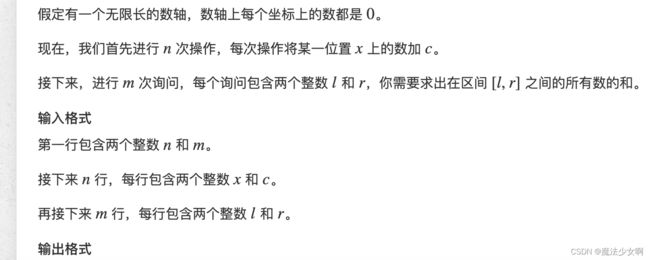双指针-位运算--离散化--区间合并
- 双指针算法
:
1.核心
优化时间? 两个指针扫描一个序列,时间花费是O(n);

for(int i=0,j=0;i<n;i++){
while(j<(根据题意)&& check(){
....
}
}
模板:
for (int i = 0, j = 0; i < n; i ++ )
{
while (j < i && check(i, j)) j ++ ;
// 具体问题的逻辑
}
常见问题分类:
(1) 对于一个序列,用两个指针维护一段区间
(2) 对于两个序列,维护某种次序,比如归并排序中合并两个有序序列的操作
做法:
第一步:先想一下朴素做法,也就是暴力做法
java
package 大学菜;
import java.io.BufferedReader;
import java.io.IOException;
import java.io.InputStreamReader;
/*
*
数据范围
1≤n≤105
输入样例:
5
1 2 2 3 5
3
**/
public class 最长不重复子序列 {
static int num = 100010;
static int[] A = new int[num];
static int[] S = new int[num];
static int[] G = new int[num];
static int[] B = {1, 2, 2, 3, 5};
//hash表的使用,在原来的地方加一
public static int find(int[] A,int l,int r){
//
int res = 0;
for(int i=0,j=0;i<r;i++){
S[A[i]] = S[A[i]]+1;
while (j<i && S[A[i]]>1){
S[A[j]]--;//这个是一开始的i,所以这个i此时已经不在这个,当前的i=0
j++;
}
res = Math.max(res,i-j+1);
}
return res;
}
public static void main(String[] args) throws IOException {
//双指针算法来找
BufferedReader reader = new BufferedReader(new InputStreamReader(System.in));
//
//5
//1 2 2 3 5
String str1 = reader.readLine();
int n = Integer.valueOf(str1);
//接收数组
String[] str2 = reader.readLine().split(" ");
for(int i=0;i<n;i++){
A[i] = Integer.valueOf(str2[i]);
}
//查找
int res = find(A,0,n);
System.out.println(res);
}
}
第二步:
看看有没有单调关系,进行缩小时间复杂度,重复元素的判断。:
暴力判断是每次都是j=0;i=0;而更好的做法是j不用重新从零判断,从i当前的位置判断。
check函数是用来判断是否存在重复元素。
就是使用hashmap的方法进行使用在同样的值的地方进行数组上面的++。
- 位运算
二进制的转换:
x 变成二进制
-x 取反
+1
x &(-x+1) = 最后的一位1 的运算
//应用到数据可以检查有多少个1,每次剪掉1;
c++(lowbit运算)使用java进行实现
public static int lowbit(int x){//与运算
return (x & -x);
}
代码:
package 大学菜;
import java.io.BufferedReader;
import java.io.IOException;
import java.io.InputStreamReader;
/*
给定一个长度为n的数列,请你求出数列中每个数的二进制表示中1的个数。
输入格式:第一行包含整数 n。第二行包含 n 个整数,表示整个数列。
输出格式:
共一行,包含 n 个整数,其中的第 i 个数表示数列中的第 i 个数的二进制表示中 1 的个数。
5
1 2 3 4 5
1 1 2 1 2
*/
public class 二进制中的1个数 {
static int num = 10010;
public static int lowbit(int x){//与运算
return (x & -x);
}
public static void main(String[] args) throws IOException {
//int
BufferedReader reader = new BufferedReader(new InputStreamReader(System.in));
String str = reader.readLine();
int n = Integer.valueOf(str);
//数组
String[] str1 = reader.readLine().split(" ");
for(int i=0;i<n;i++){
int q = Integer.valueOf(str1[i]);
int res=0;
//对q进行使用lowbit
while (q!=0){
q = q - lowbit(q);
res = res+1;
}
System.out.print(res+" ");
}
}
}
题目:
人类做题:
dfs的过程
- 离散化
值的跨度特别大,导致的空间浪费。
要进行离散化----数据个数的映射-
从稀疏到密集的变化。
1.去重
2.
模板
vector<int> alls; // 存储所有待离散化的值
//java--键值对
class Pairs{
int l,r;
public Pairs(int fir,int sec){
this.l = fir;
this.r = sec;
}
}
//c++
sort(alls.begin(), alls.end()); // 将所有值排序
//java
Collections.sort(alls);
//
alls.erase(unique(alls.begin(), alls.end()), alls.end()); // 去掉重复元素
// 二分求出x对应的离散化的值
int find(int x) // 找到第一个大于等于x的位置
{
int l = 0, r = alls.size() - 1;
while (l < r)
{
int mid = l + r >> 1;
if (alls[mid] >= x) r = mid;
else l = mid + 1;
}
return r + 1; // 映射到1, 2, ...n
作者:yxc
package 大学菜;
import java.util.*;
//3 3
//1 2
//3 6
//7 5
//1 3
class Pairs{
int l,r;
public Pairs(int fir,int sec){
this.l = fir;
this.r = sec;
}
}
public class 离散化2 {
static int le = 300010;
static int[] A = new int[le];//存储原先的数
static int[] S = new int[le];//存储前缀和
//unique函数
public static int unique(List<Integer> list){//此时alls已经是有序的,使用什么方法进行重复
//双指针
int j =0;
for(int i=0;i<list.size();i++){
//找到一个重复的就之后往后移动,否则前指针等于后指针
//后指针是i,因为每次都会进行移动,前指针是j,只有不重复时才可以移动
if(i==0 || list.get(i) != list.get(i-1)){
list.set(j,list.get(i));
j++;
}
//最后的j就是数组最后的右边界
}
return j;
}
public static int find(int x,List<Integer> list){
//二分查找
int l = 0;
int r = list.size()-1;//不是下标,是大小
while (l<r){
int mid = l+r+1>>1;
if(list.get(mid)<=x){
l = mid;
}else {
r = mid-1;
}
}
return l+1;//下标
}
//数轴点:第一次的输入的x,第二输入的l,r。
//存储区间点加操作的的,点和值(x,c)
//存储区间点求和操作的,左右区间(l,r)
public static void main(String[] args) {
Scanner sc = new Scanner(System.in);
int n= sc.nextInt();
int m = sc.nextInt();
//定义结构体
List<Integer> alls = new ArrayList<>();//放所有的x,l,r
//定义成对存放的数据
List<Pairs> xc = new ArrayList<>();
List<Pairs> lr = new ArrayList<>();
//n
for(int i=0;i<n;i++){//n个数据对
int x = sc.nextInt();
int c =sc.nextInt();
Pairs y = new Pairs(x,c);
xc.add(y);
alls.add(x);
}
//m
for(int i=0;i<m;i++){
int l = sc.nextInt();
int r = sc.nextInt();
Pairs y = new Pairs(l, r);
lr.add(y);
alls.add(l);
alls.add(r);
}
//alls已经放好了,数据对,和查询对也都放好,对alls进行离散化
//1.排序-集合的排序-list可以使用
Collections.sort(alls);
//2.去重
int end = unique(alls);
alls.subList(0,end);
//放置数据
for(Pairs p:xc){
int x = p.l;
int c = p.r;
int index = find(x,alls);
A[index] = A[index]+c;
}
//求前缀和
for(int i=1;i<=alls.size();i++){// 因为,all是离散化后的数据
S[i] = S[i-1]+A[i];
}
for(Pairs p:lr){
int l = find(p.l,alls);
int r = find(p.r,alls);
System.out.println(S[r] - S[l-1]);
}
}
}
- 区间合并:
很快求并集区间 ,快速进行求解区间段个数。
模板:
c++:
// 将所有存在交集的区间合并
void merge(vector<PII> &segs)//存储
{
vector<PII> res;
sort(segs.begin(), segs.end());//排序
int st = -2e9, ed = -2e9;
for (auto seg : segs)
if (ed < seg.first)
{
if (st != -2e9) res.push_back({st, ed});//看看左端点和有端点的关系。
st = seg.first, ed = seg.second;
}
else ed = max(ed, seg.second);
if (st != -2e9) res.push_back({st, ed});
segs = res;
}
作者:yxc
java:
class Pair2s{
int fir;
int sec;
public Pair2s(int fir,int sec){
this.fir=fir;
this.sec=sec;
}
}
Pair2s[] pa= new Pair2s[n];//数组里面放的是pair类型的数组
//对数组进行排序
Arrays.sort(pa,(o1, o2) -> {return o1.fir - o2.fir;});//sheng序排xu
//比较端点
int num = 0;
int max = Integer.MIN_VALUE;
for(int i=0;i<n;i++){
//比较
if(max<pa[i].fir){//右边没有左边大,说明有一个新的区间
num++; }
max = Math.max(max,pa[i].sec);//max>=说明有交集或者正好借接住区间,需要 合并,max需要变化到,此时的有端点。
}
return num;
}
package 大学菜;
import java.lang.reflect.Array;
import java.util.*;
/*
5
1 2
2 4
5 6
7 8
7 9*/
class Pair2s{
int fir;
int sec;
public Pair2s(int fir,int sec){
this.fir=fir;
this.sec=sec;
}
}
public class 区间合并 {
public static int hebing(Pair2s[] pa,int n){
//对数组进行排序
Arrays.sort(pa,(o1, o2) -> {return o1.fir - o2.fir;});//生序排序
//比较端点
int num = 0;
int max = Integer.MIN_VALUE;
for(int i=0;i<n;i++){
//比较
if(max<pa[i].fir){//右边没有左边大,说明有一个新的区间
num++;
}
max = Math.max(max,pa[i].sec);//max>=说明有交集或者正好借接住区间,需要合并,max需要变化到,此时的有端点。
}
return num;
}
public static void main(String[] args) {
Scanner sc = new Scanner(System.in);
int n = sc.nextInt();
Pair2s[] pa= new Pair2s[n];//数组里面放的是pair类型的数组
for(int i=0;i<n;i++){
int l = sc.nextInt();
int r = sc.nextInt();
pa[i] = new Pair2s(l,r);
}
//按左端点排序
int ans = hebing(pa,n);
//比较左端点
System.out.println(ans);
}
}






